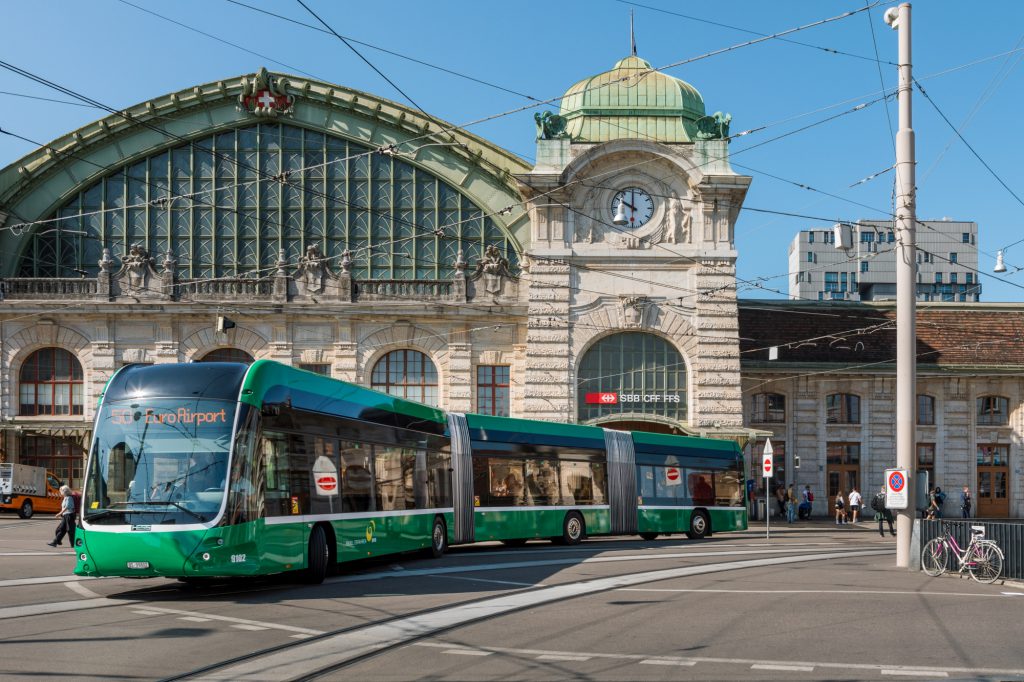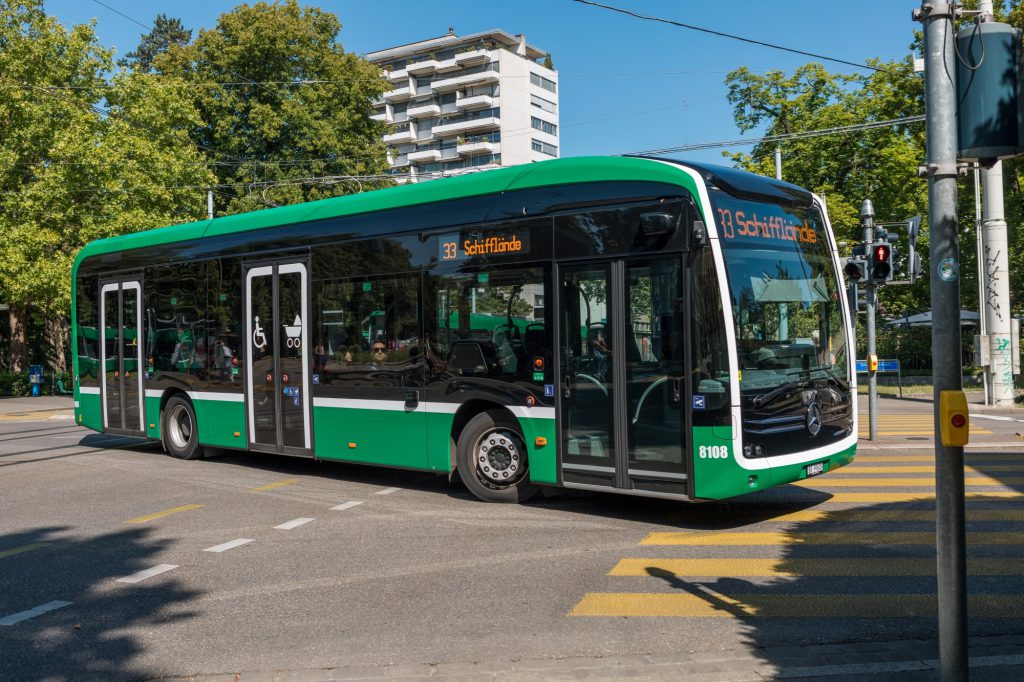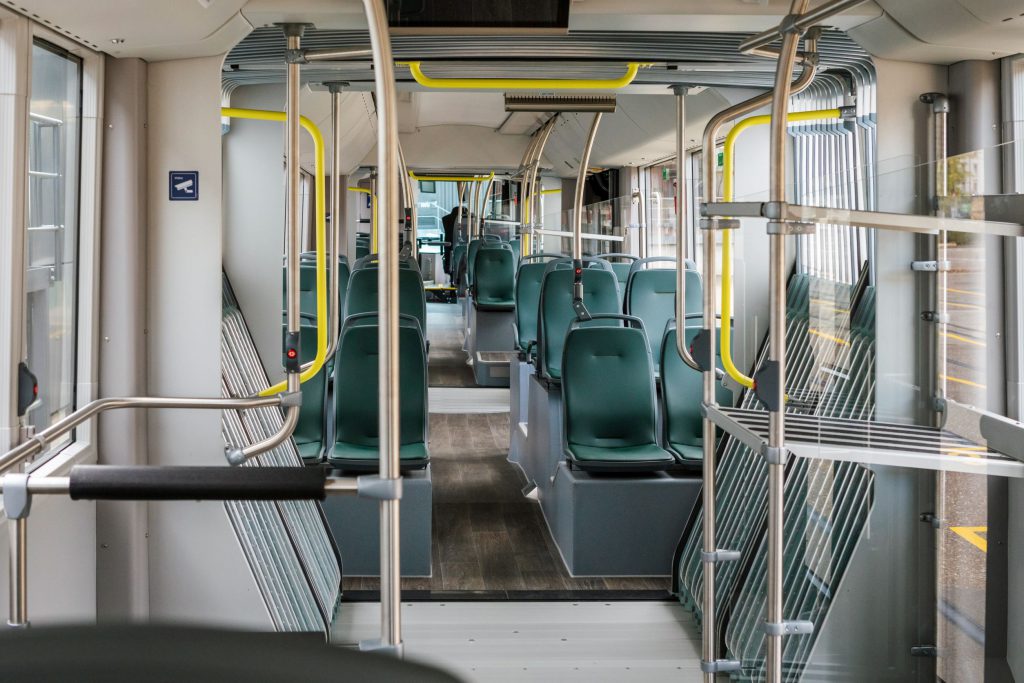BVB is planning to modernise its entire bus fleet by 2027 and switch completely to battery-electric buses (e-buses). In doing so, it is implementing the legal requirement that all public transport in Basel-Stadt must be powered by 100 per cent renewable energy from 2027. In addition to the procurement of 126 e-buses in two procurement phases in 2022/2023 and 2027, the infrastructure also needs to be adapted: The Rank garage must be rebuilt and adapted to the requirements of e-buses. In addition, opportunity charging stations will be installed at probably five final stops on longer bus routes, where the e-buses can recharge their batteries en route. Investments totalling around CHF 360 million are required to enable the conversion to the e-bus system. The corresponding loan request was approved by the Grand Council of the Canton of Basel-Stadt on 9 December 2020. Here you will find answers to the most frequently asked questions.
Why is BVB focussing on e-buses?
What is the environmental footprint of e-buses?
How are the e-buses charged?
How, when and which e-buses will be procured?
Why does the Rank car park have to be rebuilt?
Where will the buses be parked during the construction work on the Rank garage?
What will happen to the old batteries?
How much will the conversion to the e-bus system cost?
What will change for passengers and the people of Basel with the 2027 bus system?
Why is BVB focussing on e-buses?
BVB has tested various drive technologies that fulfil the legal requirement for 100 percent renewable energy. It decided in favour of e-buses for various reasons:
E-buses have a good environmental balance, provided they are charged with 100 per cent renewable electricity, as is the case with BVB. They do not emit any exhaust gases (CO2, nitrogen oxides, fewer particles) when travelling and are significantly more environmentally friendly over their entire life cycle than diesel buses, for example. E-buses are also quieter than today’s buses, especially at low speeds, when accelerating and at bus stops. They are very energy-efficient and can recover energy when braking. This is a major advantage, especially in urban traffic with lots of braking. BVB’s “stromnibus”, for example, recovers around 40 per cent of its energy when braking. Ultimately, e-buses are also the most economical solution for the BVB network in the long term. Various other cities, such as Munich and Hamburg, have also opted for e-buses.
You can find out more in the factsheet on the environmental impact (in German), drive types (in German) and noise emissions (in German).
What is the environmental footprint of e-buses?
The type of electricity they run on is crucial for the environmental footprint of e-buses. As with the trams, BVB uses 100 per cent renewable electricity. E-buses do not emit any exhaust gases when travelling. This means that no toxic nitrogen oxides, no CO2 and no particles are emitted. Every year, the future e-bus fleet will save around 10,000 tonnes of CO2 compared to the current bus fleet. This is roughly equivalent to the annual CO2 emissions of 3,500 average cars. Over its entire life cycle, including the production of the batteries, the e-bus fleet produces around 85 per cent less CO2 compared to the current bus fleet because it does not emit any CO2 when driving. After around two years, the environmental costs of producing the fleet of the future (in particular the production of the batteries) are already offset due to the significantly lower CO2 emissions during operation. The environmental footprint of e-buses is therefore significantly better than that of the existing bus fleet.
You can find out more in the factsheet on the environmental impact (in German).
The necessary charging infrastructure must be set up for the switch to the e-bus system. From 2027, the e-buses will mainly be charged in the Rank garage, which will have to be rebuilt and equipped with charging stations. Opportunity charging stations are also planned at an estimated five final stops, where the e-buses can recharge their batteries during their final stop. This will make the entire bus system more flexible and fewer e-buses will need to be procured. In 2022/2023, opportunity charging stations were implemented at the EuroAirport Administration and Kleinhüningen stops. The need for the other three opportunity charging stations will be reviewed again in 2025. IWB (Industrielle Werke Basel) is responsible for the entire traction current supply.
You can find out more in the factsheet on depot charging/occasional charging (in German) and the new construction of the Rank garage (in German).
How, when and which e-buses will be procured?
BVB plans to procure a total of 126 e-buses. 65 e-buses were procured in 2022/2023, and a further 61 e-buses are to be procured in 2027. In addition to 19 standard electric buses and 38 articulated electric buses from EvoBus (Schweiz) AG, eight double-articulated electric buses from the Swiss manufacturer Carrosserie HESS AG were also procured for line 50 in the 2022/2023 procurement phase because this line had reached its capacity limit (see media release dated 18 May 2021 and media release dated 2 September 2021). At around 25 metres in length, double-articulated buses are longer than articulated buses (18 metres) and can transport around 50 percent more passengers per bus. With the eight electric double-articulated buses, the transport capacity on route 50 can be increased by 17 per cent. And with practically the same operating costs. Test runs on line 50 had shown that the use of double-articulated buses is possible without major adjustments to the infrastructure. The double-articulated buses are charged using occasional charging stations. The first electric standard buses and electric double-articulated buses were delivered in November 2022. On 19 December 2022, the first standard electric buses started passenger service, mainly on routes 33, 42 and 46, and the first double-articulated electric buses have been in passenger service on route 50 since 16 January 2023. The first articulated electric buses were delivered on 27 June 2023.
On 4 September 2023, the first articulated electric buses went into passenger service on lines 30 and 36. By the end of 2023, these two lines in particular were fully electrified and all 38 electric articulated buses were put into operation.
You can find out more in the factsheet on the double-articulated buses (in German) and the use of e-buses (in German).
This is what the e-buses look like:



Why does the Rank garage need to be rebuilt?
Today, the Rank garage is the only location for parking and maintaining the buses. It was built in the 1950s and extended in the 1970s. It no longer fulfils the requirements of a modern garage. For example, it would have to be earthquake-proofed. In addition, it is already too small and not all buses can be parked in the car park itself. And finally, it does not make economic sense to make any adjustments or extensions to the garage, which is in need of renovation.For all these reasons, the Rank garage needs to be rebuilt, even independently of the switch to the e-bus system.
You can find more information in the factsheet on the new construction of the Rank garage (in German).
Where will the buses be parked during the construction work on the Rank garage?
During the construction work on the Rank garage, the buses will be parked on two temporary sites: Most of the e-buses procured in 2022/2023 will be parked in Exhibition Hall 3, which has been equipped with the appropriate charging infrastructure. The remaining e-buses and remaining diesel buses will be parked on the Swisslife site in Klybeck (former Ciba site). Construction work on the two temporary facilities began in November 2021. The temporary Klybeck site was put into operation in November 2022 and the temporary Messehalle 3 site in October 2023. Both temporary structures will be dismantled once the construction work on the Rank garage is complete.
You can find more information in the temporary structures factsheet (in German).
What happens to the old batteries?
The batteries in an e-bus have a service life of around seven years. At this point, they still have around 80 per cent of their capacity. This is sufficient for a second use as stationary energy storage, for example for solar systems. If this is not possible or an option, the batteries can be recycled. In the public tender for the e-buses, BVB requires suppliers to submit a concept for the reuse or environmentally friendly recycling of the batteries. It also requires suppliers to provide proof of sustainability. Manufacturers must be able to demonstrate a procurement strategy specifically for battery raw materials from developing countries. Only if a manufacturer can provide this evidence will it be awarded the contract to produce the e-buses.
You can find out more in the factsheet on battery recycling (in German) and in the factsheet on battery raw materials (in German).
How much does the switch to the e-bus system cost?
The conversion to the e-bus system will cost around CHF 360 million in total. CHF 308 million of this will be invested by BVB, in particular for the e-buses and the construction of the new Rank garage. 52 million francs will be needed to provide the traction power supply. This is the responsibility of IWB (Industrielle Werke Basel). The Grand Council of the Canton of Basel-Stadt approved these funds in December 2020.
The canton of Basel-Stadt has submitted the 2027 bus system for co-financing by the federal government in the 4th agglomeration programme. With this programme, the federal government also contributes financially to transport projects in the agglomerations, among other things. The Federal Assembly has approved the 4th Agglomeration Programme 2023. The loan from the Canton of Basel-Stadt will be reduced accordingly.
You can find more information in the factsheet Costs of converting to e-buses (in German).
What will change for passengers and the people of Basel with the 2027 bus system?
Passengers and the people of Basel will benefit from a modern, city-friendly and environmentally friendly bus system: the biggest change is that electric buses are quieter than the current diesel and gas buses. E-buses make significantly less noise, especially at low speeds, when accelerating and at bus stops. Noise pollution from buses in neighbourhoods will therefore decrease. Travelling by bus itself will be more comfortable. Thanks to the latest technology, e-buses are also safer. They also emit no exhaust fumes when travelling. They therefore also make an important contribution to cleaner air in Basel. All in all, they make a significant contribution to a higher quality of life in and around Basel.
